The spring of 2023 in California was abnormally cool, making avocado thrips abnormally populous. Thrips are tiny insects that chew on avocado fruit as the fruit is small, and this chewing becomes brown scarring.
The thrips damage can result in large patches that some people call “alligator skin.” But if the chewing is minor, the result is only faint brown lines.
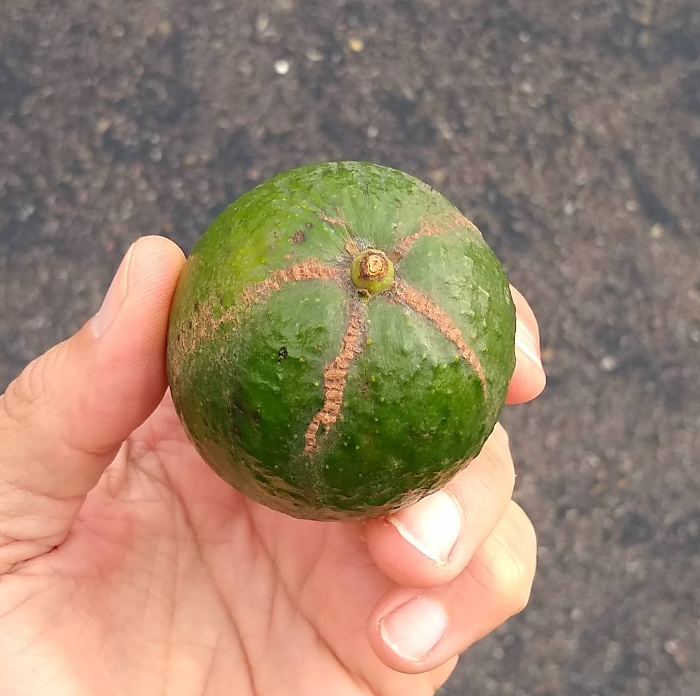
Thrips like it cool
The avocado trees in my yard in the foothills of San Diego County are usually not an attractive feeding ground for thrips. In the past decade, I had seen almost zero thrips damage. In 2023, I saw the most ever.
At an avocado farmer event at Cal Poly San Luis Obispo in August of 2023, Brett Chandler of Associates Insectary said that he was seeing the worst thrips damage in 20 years, and he said it was because of the long, cool spring.
Heat “burns out” thrips, said Chandler. Inland locations (such as mine) see less thrips damage than coastal locations, in general, because “thrips numbers are suppressed by warm, dry conditions,” according to the page on avocado thrips by the University of California.
Before I learned about why, I had always noticed that avocados trees close to the beach had worse thrips scarring on their fruit compared to avocado trees farther inland. Chandler said that even a few miles can make a difference: In Ventura County, Fillmore gets almost no thrips damage whereas Santa Paula gets 40% damage because it’s just enough cooler (at around eight miles closer to the ocean).
What to do?
So move inland. Oh, that’s not a viable option? Sorry. Then warm up the spring weather. Not a helpful suggestion either?
Before thinking about what to do, note that brown skin on avocados can be caused by things other than thrips and sometimes it’s hard to discern the cause.
Other causes of brown skin on avocados
Two types of skin damage on avocados that are most easily confused with thrips scarring are rub scars and russeting.
Rub scars are caused by the fruit rubbing against something as it hangs on the tree. The fruit usually rubs against branches or other avocados.
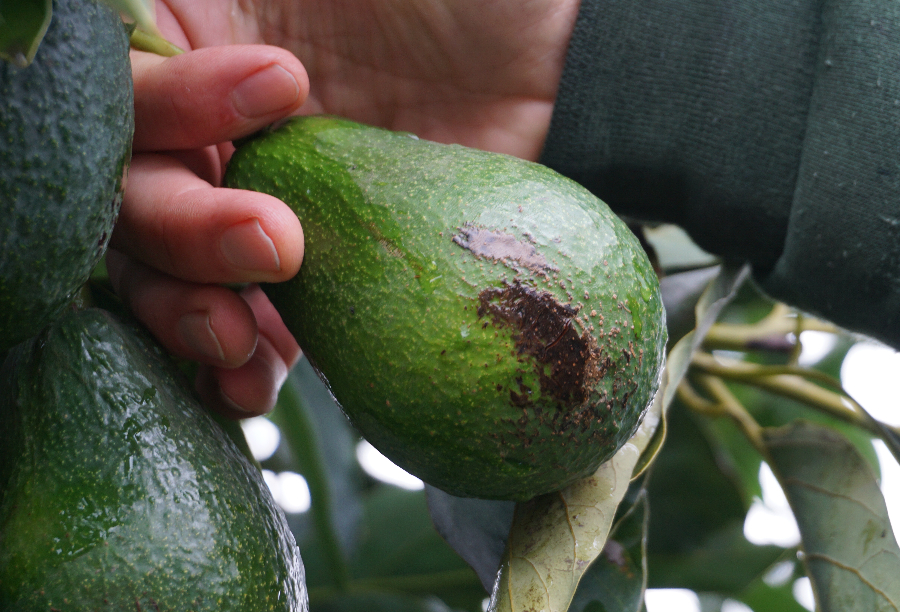
Russeting, also sometimes called corking, appears on the skin of some varieties as the fruit reaches maturity. It’s not caused by any external force; it’s just an indication of maturity. Varieties that I’ve seen russet a lot include Edranol, Thille, Nabal, and Nowels.
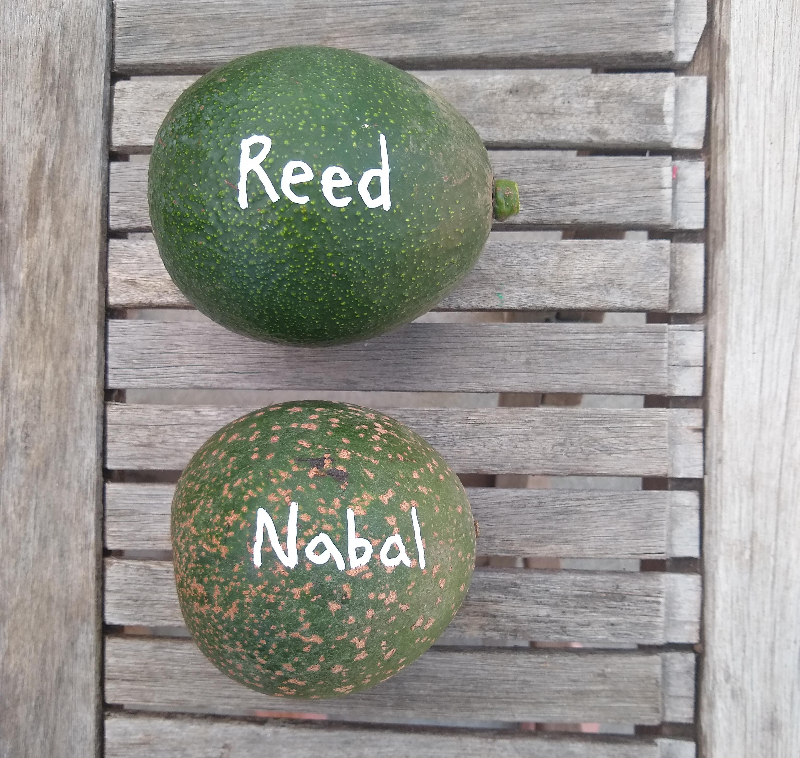
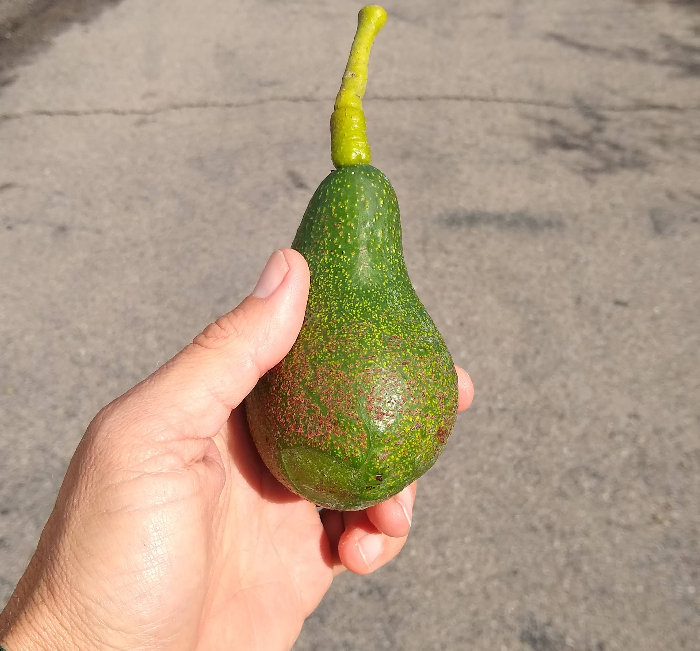
(For more pictures of scarring on avocados, see this page of photos from the University of California.)
What to do to prevent thrips scarring: Spray?
For thrips scarring on avocados, some farmers in California spray their trees in order to kill the thrips and minimize their damage because scarred avocados fetch a lower price. Farmers and pest control advisers tell me that the standard spray for non-organic farmers is Agri-Mek, which is produced by Syngenta, a company owned by the China National Chemical Corporation. And the standard spray for organic farmers is Entrust, which is produced by Corteva, a public company that had been owned by DowDuPont until 2019.
Both of these insecticides are toxic to many other insects besides avocado thrips, including bees, according to their safety data sheets (found in links above).
Encourage thrips predators
What can be done to minimize thrips damage without spraying? One idea is to develop a yard or farm that is hospitable to avocado thrips predators.
When I say avocado thrips I’m referring to Scirtothrips perseae. There are many other species of thrips; there are even other species that eat avocado thrips. (See photos and descriptions of “good” thrips species here.)
So you want habitat for other thrips that prey on avocado thrips, and you want habitat for the other natural enemies of avocado thrips, such as green lacewings. That would mean not spraying pesticides and having nectar and pollen available, which means either planting flowers or allowing weeds to flower, or both.
Encourage spring leaf growth
Another idea is to encourage spring leaf growth. At the Cal Poly SLO event, Brett Chandler explained that thrips start out feeding on succulent new leaves in the spring, but as those leaves harden, the thrips move onto tiny avocados to feed. If you can induce your tree to continue growing many new leaves while the setting fruit is still small, then “more of the thrips population will remain on tender foliage,” as it is put in Avocado Production in California (Book 2, Chapter 5, page 112).
I saw evidence to support this in one of my Hass trees during 2023. On certain (girdled) limbs, the tree set so much fruit that few leaves grew during spring. Thrips damage on the avocados of these limbs was widespread. In contrast, the avocados on the other (non-girdled) limbs on the same tree had noticeably less thrips damage; those limbs had grown many more new leaves throughout spring.
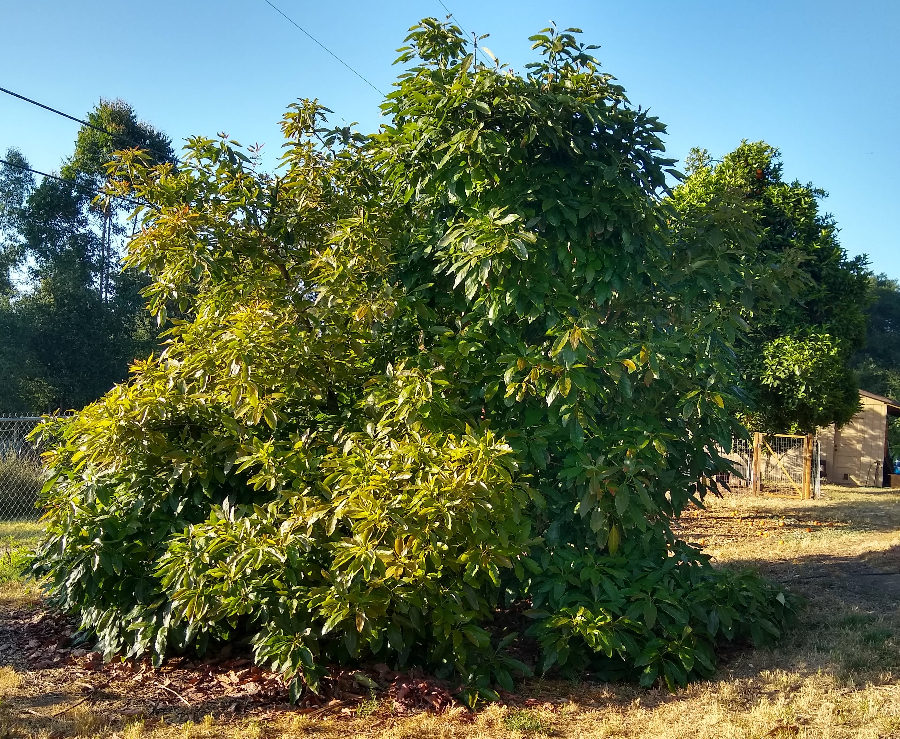
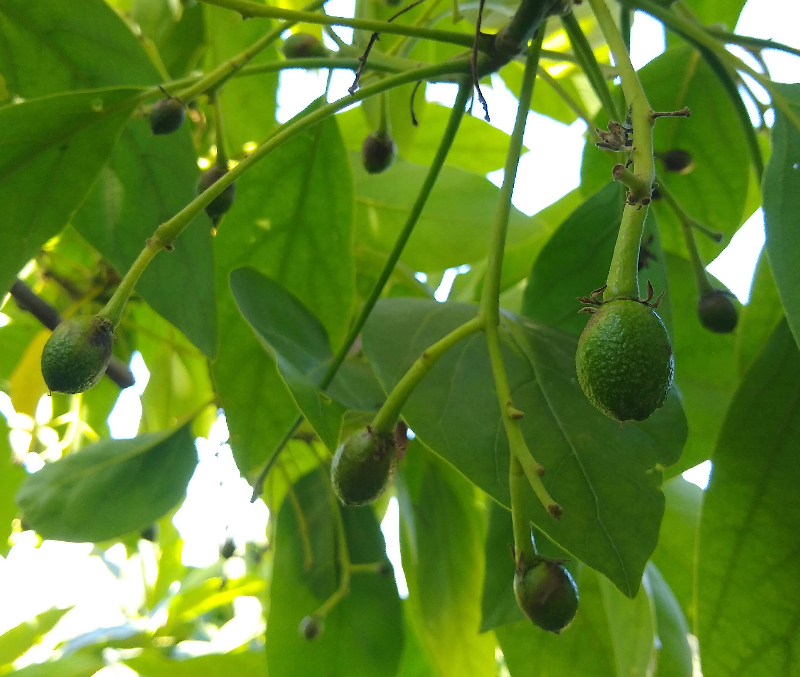
But what to do with this observation? How to encourage more spring leaf growth? Don’t girdle too large a portion of a tree’s canopy. And make sure the tree has enough soil fertility to support both fruit growth and leaf growth.
Bottom line
But the bottom line is that we’re stuck with our location’s climate and each spring’s weather, and these factors make a big difference. So we must tolerate a certain amount of scarring from thrips on our avocados.
Luckily, the damage is usually only skin deep. Only if the damage is extensive does it affect the avocado’s eating quality or limit the ability of the avocado to develop normally.
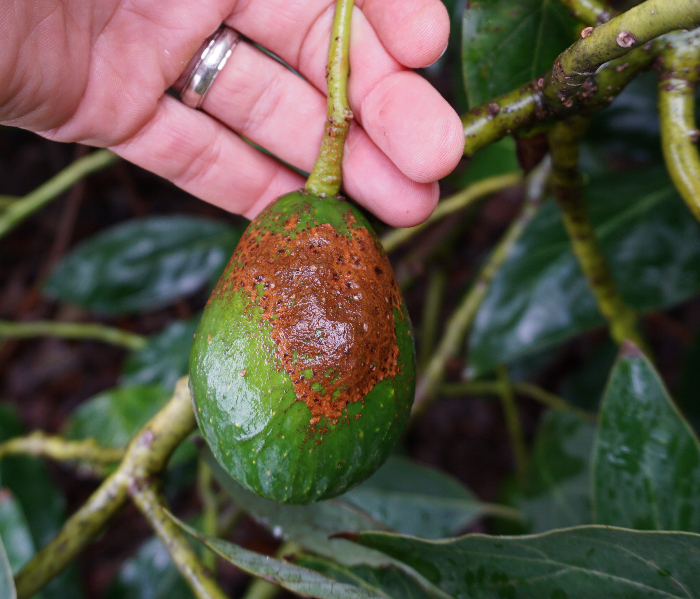
Here we are in the middle of winter 2024. Will late winter and spring 2024 be wet and cool like 2023 was? Nobody knows.
What is known is that the California Avocado Society is offering a seminar next week just in case. “How to manage avocado trees in a wet year,” is the seminar’s title. It takes place in Ventura (and on Zoom) on February 15. Thrips will be one of the main topics covered. The seminar is free and all are invited to attend. I hope to learn more about thrips at the seminar and update this post accordingly afterward.
Check out all of my Yard Posts here.
No ads on The Yard Posts! That’s because of the contributions of Supporters like you. Thank you.

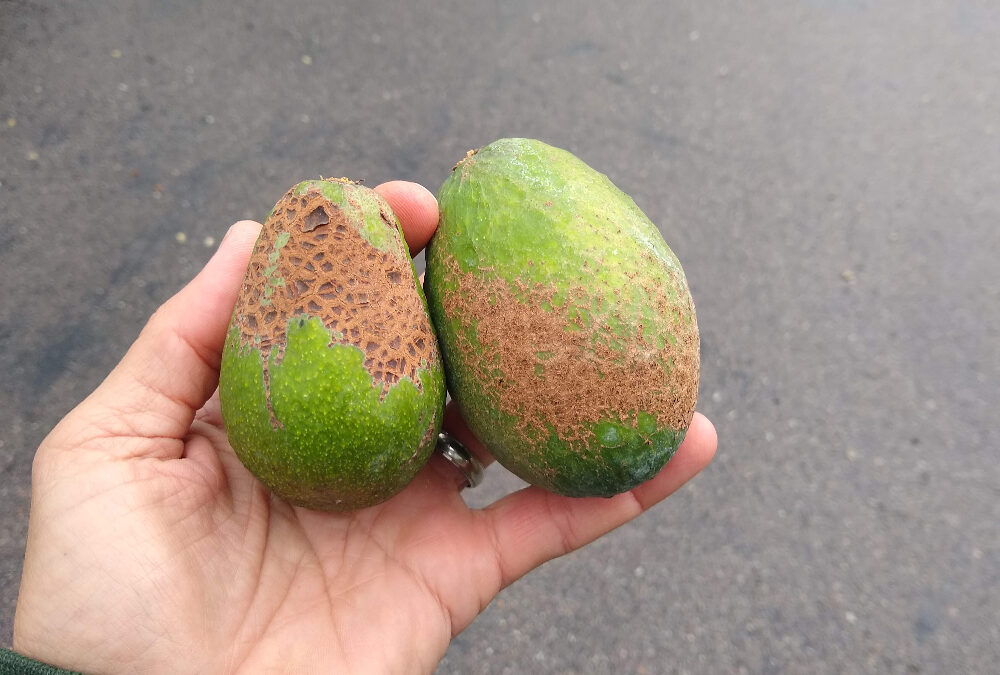


Thanks for the warning. I found this information which may be useful. Good luck with those little critters.
https://www.planetnatural.com/pest-problem-solver/houseplant-pests/thrips-control/
I’ve had good luck spraying water to reduce pests like perseid mites. Have yet to get thrips but it’s usually better to leave any pest to act as “bait” for their natural predators. I’ve had to break down and spray apple blossoms to break the coddling moth cycle. Regarding superficial imperfections on avocados, I would be more confident buying them than buying imported avocados with hidden gray flesh.
The gray flesh is the result of the fruit being old. This type of damage is the result of fruit being weeks old and in storage.
When the avocado has a brown spot on the side. It’s good for you to eat you could eat the avocado like this. It’s not dangerous.
Thank you for the enlightenment. I live in San Francisco and buy ugly produce from Chinatown, Mission Street (Mexican), corner stores and farmers at flea markets, who have the most tasty and fresher choice. Occasionally Safeway because of the wide variety, in spite of higher prices. Beauty is skin deep. As is not produce. They’re grown for display, not for nutrition.
I wholeheartedly agree with you, Sussana. It’s sad but true. Farmers know this. In fact, when I sell avocados, I sell blemished ones as “farmers avocados” because they are the ugly ones that don’t fetch the high price but are just as delicious and nutritious inside; they’re the avocados that the farmers themselves eat.
In my neck of the woods, the Smart and Final has an “ugly produce” table in the back. I see the inner beauty and love a bargain! And good to know what makes the gray in avocados. I was in storage too long, too. 🙂
Thank you all for this site!!
I have avocados on the tree that look like cracks and then the thin colored part of the skin starts to peel away from the cracks. Is this from Thrips?
I have 1 Sharwil avacado tree in my yard which usually sets fruit about mid March. When should I start to put on a neem oil soak to deter Lacey Bugs ?
Is one soak every 3 weeks enough ? For how many weeks ? Thank you
Larry
Thank you all for this site!!
I think I have a Stewart tree. This year the tree is packed with fruit (first time). The problem I have is that the mid to large size avocados skin is getting what looks like cracks in them. Some of the fruit looks like scabs on them. Does anyone know what the problem is?
Hi Kenneth,
That skin cracking just happens to Stewart avocados at full maturity. It’s an unfortunate characteristic of the variety. You can see such cracking on a Stewart avocado in my video profile about a minute in: https://gregalder.com/yardposts/stewart-avocado-tree-a-profile/
Thank you so much, you’re so kind to answer my questions! I’m only guessing the tree is a Stewart. It doesn’t look like the one in the video but the harvest time seems to line up. The cracks on mine are all over the fruit not just at the stem. I wish I could send a picture to verify the type and problem. Thank you so much for your time!
Hi Greg. I’m not sure if this was covered in a previous post or comment. I have a tree that gave me fruit the first time this year. The problem is the fruit has large woody/calcified areas in the fruit. They look like a woody layer within the meat. I have never seen this exact thing before and was hoping you would have some insight. Is this normal for a young tree, maybe some nutrient imbalances? Thanks ahead of time Greg.
Hi Walter,
This is strange. Nothing apparent outside, but only inside is the woody/calcified areas?
The only thing that comes to mind is that some varieties, such as Fuerte, will get “stones” in the flesh very late in their season. It’s a phenomenon like you described.
Thanks for the response Greg! The tree was labeled Fuerte when I bought it from sub tropica.
I have been having suspicions that it was mislabeled because the skin is thick and bumpy.
Maybe my suspicions were incorrect and I just picked them too late in the year
Thank you for all the info you provide here. I have a Gem Hass that is approx 10 yrs old now. This past year it has been infested with thrip. I thought the brown was sun damage or rubbing. But an arborist let me know that it was from thrips. My question for you is when I bring the avocados into the house should I be concerned about bringing the thrips inside. I would not want them to attack my houseplants. Thanks!